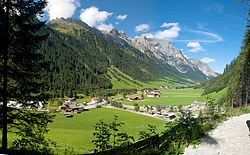Gschnitz
| Gschnitz | ||
|---|---|---|
 |
||
|
||
| Location within Austria | ||
| Coordinates: 47°02′39″N 11°20′58″E / 47.04417°N 11.34944°ECoordinates: 47°02′39″N 11°20′58″E / 47.04417°N 11.34944°E | ||
| Country | Austria | |
| State | Tyrol | |
| District | Innsbruck Land | |
| Government | ||
| • Mayor | Christian Felder | |
| Area | ||
| • Total | 59.1 km2 (22.8 sq mi) | |
| Elevation | 1,242 m (4,075 ft) | |
| Population (1 January 2016) | ||
| • Total | 424 | |
| • Density | 7.2/km2 (19/sq mi) | |
| Time zone | CET (UTC+1) | |
| • Summer (DST) | CEST (UTC+2) | |
| Postal code | 6150 | |
| Area code | 05276 | |
| Vehicle registration | IL | |
| Website | www.gschnitz.eu | |
Gschnitz (German pronunciation: [ˈkʃnɪt͡s]) is a municipality with 415 inhabitants (1 January 2011) in the southern part of the district of Innsbruck-Land and is located 25 km (16 mi) south of Innsbruck.
Gschnitz is placed at the end of the valley of the same name which branches off from the Wipptal at Steinach am Brenner. The municipality borders cross from the Talschluss (3,277 m, 10,751 ft) to the South Tyrol. The Gschnitz brook provides the village with drinking water.
Brenner, Neustift im Stubaital, Obernberg am Brenner, Trins.
The village is mentioned for the first time in 1284 as "Gasnitz". In 1288 the valley had nine Schwaighöfe (alpine farms) seven of them in Gschnitz, which formed the centre of the village, and two at Laponesalm. The right of succession in Tirol originated from these nine Schwaighöfe and was adopted in all the other valleys in the region. In 1471 the rivalry between Gschnitz and Trins arose and reached a point that the inhabitants of the two villages blocked the entrance to the valley; the Steinach am Brenner Court had to intervene to resolve the dispute. Gschnitz was awarded the status of a municipality in 1811. Major development occurred from the 18th century onwards.
Gschnitz's coat of arms consists of a red background, crossed by three horizontal stripes, one of each, consisting of six lozenges, alternating white and black. This visualization looks like the roof of the nine mountain farms. The coat of arms was made official January 10, 1984
...
Wikipedia



